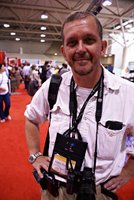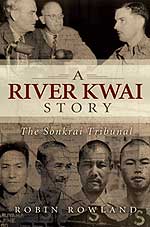Updated Aug. 25

CBC News assigned me to photograph the 2006 AIDS conference in Toronto last week. I didn’t attend many sessions, just the ones our science writers were covering. I shot the day of protests on Wednesday and the vigil Thursday evening. I did watch most of the coverage provided by CBC News as host broadcaster.
Robin covering the AIDS conference, photograph taken by CBC cameraman Martin Trainor.
The CBC had two bloggers at the conference.
Quirks and Quarks producer Pat Senson
St. Michael’s hospital physiotherapist Julie Hard
I also found the blog by San Francisco’s 3D Dancer interesting.
Here are my thoughts.

The vigil
CBC photo gallery AIDS 2006: The Vigil
The AIDS vigil at Toronto’s Dundas Square on Thursday evening is best described as a solemn celebration. Vigils in Toronto a decade ago were sad and solemn, tears and candlelight and choking silence.
It’s seems only yesterday that soon after I returned from a year of living in England, that I read a one paragraph brief in Discover magazine about this mysterious new disease that was affecting gay men (then) in New York, Los Angeles and San Francisco.
Now it’s been 25 years and too many friends who aren’t here any more. (There was a display of AIDS quilts in the CBC atrium. One was in memory of my friend Jim Jefferson, who I knew as a journalism student at Carleton University and who, as a reporter for The Globe and Mail in the late 1970s was one of the first journalists in North America to come out publicly).
I arrived early and it was soon clear that the Vigil would be a celebration as students from the Etobicoke School of the Arts, students born years after the pandemic began, rehearsed a medley from Rent.
At first the crowds were rather sparse, but as the sky darkened, Dundas Square (recently developed by Toronto in hopes of making this city’s Times Square) filled up…everyone, it seemed, arrived at the last minute.
The saddest moment for me was when Sonya Marie Coté told a story called “Christian’s Exit” which reminded me of the struggle of my friends with HIV/AIDS, struggle for daily dignity, the struggle to stay alive, the struggle not to give up.
The most controversial moment was during the lighting of the candles, when a couple of voices in the crowd heckled Canadian health minister Tony Clement by yelling out “Where’s Harper?” a reference to the Prime Minister’s decision not to attend the conference. What as far as I know the rest of the media did not report, but which I mention in the photo gallery was that many others began to “Sssh,” angry perhaps that the heckling was distracting from the solemnity. On the other hand, those who have lost their friends have a right to be angry.
The one thing I found slightly disconcerting was when the audience was asked to call out the names of the dead. The names came at random, there was none of the orderly reading of names that I have done in the past at one vigil, and in other AIDS vigils as well as remembrance for others who have died in crashes and attacks.
A few yelled out names, and then there was silence, no more names and the Vigil moved on.
One of the names someone yelled was my friend James Thatcher. After James was diagnosed he emerged one of Toronto’s most respected activists, once handcuffing himself to a door at the Ontario legislature at Queen’s Park. James, who had always liked to party, left money in his will so his friends could have a real celebration of his life. It was held in a neo-gothic hall at University of Toronto’s Hart House, with lots of good scotch and good food. And why not, it was his money. It was a great party (everyone dressed to the nines in suits and ties) tinged of course with great sadness.
After the moments of silence, as glow sticks (safer than candles) were raised in the dark, the students from the Etobicoke School of the Arts returned to the stage for the upbeat, but still AIDS related, songs from Rent.
The protests
CBC photo gallery: A day of protests
Protests are part of any AIDS conference. But times have changed. On Monday, some members of ACT UP and other protestors, angry at the Bush administration’s AIDS policy showed up outside the crowded press room in the early afternoon. The majority of the reporters ignored it, busy, on deadline, filing on the conference opening, the talks by Bill Gates and Bill Clinton.
There was another similar demo on Wednesday morning, mainly by sex workers, which got some more attention (including from me)
But to get attention, a protest must have imagination. That’s what happened when those in favour of continuing the Insite safe injection site in Vancouver stopped traffic at the cross roads of Toronto, Yonge and Bloor.
The local media was out in force. If there was anyone was there from the international media, I didn’t see them, although the demo would have been a good news peg to write a story about the absolute necessity for safe injection sites and needle exchange.
Shortly after one, the protestors went into the intersection and used banners to stop traffic in all four directions. There were just a handful of police on one corner. The traffic was at a stand still for about 10, perhaps 15 minutes. The senior cop kept glancing at his wristwatch, and at the appropriate time, approached the demo leader, told him it was time to wrap up and that part was over, although a spokeswoman for the Insite program had a press scrum after the streets were cleared.
AIDS 2006:A time to deliver Retrospective gallery created for the new CBC.ca science and health sites. A mixture of wire photos and my work.
AIDS, journalism, CBC, photography, protest, vigil




